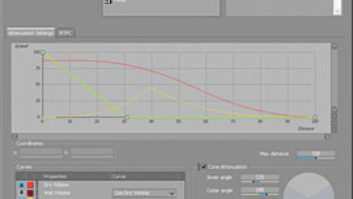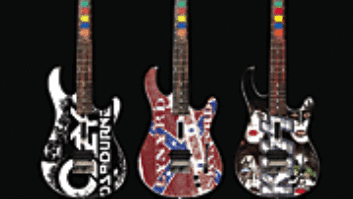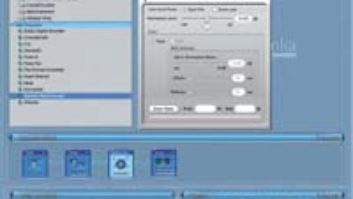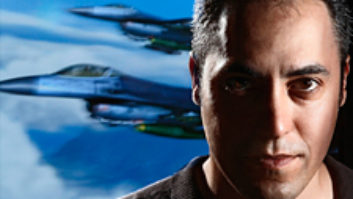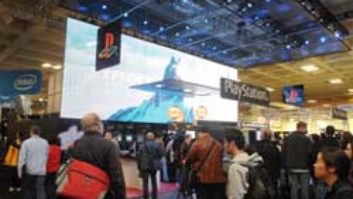
If you want a sneak peek at an industry on the rise, then the Game Developers Conference in San Francisco, March 7-9, was the place to be. Big money is being spent on audio development, of both facilities and tools, yet there were few audio exhibitors at the actual conference, despite the 12,000-plus in registered attendance. No workstation manufacturers (though Cakewalk showed off the capabilities of SONAR 6 on a dual quad-core system at an Intel-sponsored panel), no monitor makers, no controllers. Strange. That will no doubt change in coming years, as the breakthroughs in middleware bring more and more control into the hands of editors and mixers, making them less dependent on programmers to place audio in the game engines.
advertisement
But still, the audio portion of GDC is primarily a networking and panels show, and it was stellar in that regard. The top composers, mixers and supervisors all attend, it seems, and the collection of panels in the Audio Track, arrranged and developed by GDC in conjunction with Game Audio Network Guild (audiogang.org) were superb. We got a look at what’s coming with XACT2, the tool for implementing audio in Xbox, and how it will share functionality with Vista. Sony’s team of music supervisors gave a through presentation of how score is turned into actual placed music in the game, and the decisions they make to provide variety and randomization. And then others from Sony detailed the as-yet-untapped potential of develping for PS3.
Another panel, “The Importance of Audio in Gaming: Investing in Next-Generation Sound,” could have served as the running theme for the week. One by one, Scott Gershin and his fellow panelists tackled the “obstacles” hindering quality game audio: Consumer acceptance, support from decision makers and technology. Well, we know the technology (for the most part) has arrived. As for consumers, it’s clear that they are ready: 83 percent of adult gamers listed sound as one of the most important game console elements. And what’s more, 31 percent of American households are rigged for surround. More and more, they’re expecting film quality in their game experience.
So while it seems that consumers have made the leap, an issue on everyone’s minds is quite clearly getting better quality audio on the radar of game producers everywhere. How to get support from senior management? Invite them to a scoring session. Take them to a Foley stage. Show them that audio is fun. Make them a FAN.
For many, though, the highlight was a first-day presentation by the legendary Koji Kondo, composer for the Mario Bros. and Zelda series. Gamers worldwide hail Koji, whom many credit with developing the first truly interactive scores. He played clips that seemed almost nostalgic, if it weren’t for the timeless Mario music. Change arrangements, he said, chage music with character movement, randomize phrasings and match enemy movements with musical sets. Koji received multiple standing ovations, and the next night he was honored with a Lifetime Achievement Award at the annual G.A.N.G. Awards, then the following night he appeared and perrformed at Video Games Live. Legends are a sign of a mature industry, and Koji is a legend.
The last convention panel was a very cool event for composers. The G.A.N.G. Demo Derby is sort of the “American Idol” of the game sound world-Basically, these people get up in front of an audience, play a minute of their best work, and a panel of heavyweight composers critique them. But instead of “yo dawg, that’s kinda pitchy” or a weepy “you really made this your own,” these guys are providing honest, valuable feedback. (And hey, it’s free.) There’s plenty of love to go around, though, because the talent showcased today is truly amazing. We’ll definitely be hearing a lot from these composers in the near future…
All sessions are available for purchase as MP3s at www.gdconf.com.
Each day after the sessions concluded, there were parties and events. On the first night, we attended a mixer/dinner hosted by Associated Production Music and Four Bars Intertainment. More than 50 of the top composers and developers gathered at Gordon Biersch to trade stories and swap cards. Bob Rice, who represents many of the musicians, quietly ate in a corner, though almost all in the room came up to thank him for pushing their craft. The following night G.A.N.G. put on their lively awards show, where Gears of War came away the big winner and Koji was serenaded by the videogame pianist. A complete list of winners can be found at www.audiogang.org.
Finally, to close the show, Tommy Tallarico and Jack Wall put on yet another in their ongoing road show of Video Games Live at the Masonic Auditorium. VGL is a unique event featuring a full-blown orchestra playing to visual cues from the history of videogames.
A feature story on VGL’s audio production can be found in the March issue of Mix, or by clicking here.
And finally, there were audio products to be found on the floor, and our intrepid reporter Kevin Becka found them all. Dolby and Intel/Cakewalk each sponsored sessions, but out on the floor, we found the following:
The word middleware is a term you hear a lot at the GDC. The term describes software tools used by game developers to create the game. AudioKinetic was making big news at GDC with latest version of the Wwise middleware application. One of the most interesting features here is an interactive music container that makes melding music and random action easier than ever.
CRI Middleware offers a comprehensive tool suite for developers including an audio engine that allows the audio designer to build dynamic sounds that vary in both pitch and amplitude over time.
And Creative Labs was showing OpenAl, a cross-platform 3D Audio API designed for games, music and multimedia applications.
Check out Mix’s three-part series on game audio middleware that begins here.
Delivering large chunks of data efficiently and securely is a big part of doing business in an online world. Solid State Networks offers a cross-platform solution that offers customizable quality of service guarantees, web-based tools for systems management, analytics and reporting services and peer-to-peer optimizations.
Minnetonka Audio was showing the Batch Pro tool that lets users string together a group of plug-ins and processes (such as sample rate conversion), assign settings and tasks, then walk away and let the software do all the work.
The importance of quality audio output devices can’t be underestimated when you’ve got someone lurking in DEFCON 4 ready to cut your throat. Edge Acoustics, a division of Etymotic Research, had 30 gamers to compare traditional over-ear monitors with Edge’s new in-ear product, and found that the combination of isolation and flat frequency response offered in their products made a big difference in the ability to score points and escape an early demise.
And it’s not just for AES tech heads—Acoustilock was showing an isolation box that be ordered with up to 24 rack spaces and is amazingly quiet. It features rear cable ports and temperature control.
There was a hell of a lot happening at GDC. The entire second floor of the West Hall was devoted to career opportunities and education, with tabletop-style booths bringing developers and creators and schools together. There were deals being made on the visual effects side, and solutions being bandied about for tools development. If you’re looking for excitement and complexity in audio, do yourself a favor and come on out to San Francisco next March. You won’t be disappointed.
Get more reports GDC in our show podcasts and blogs.

